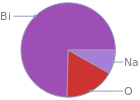Input interpretation

sodium bismuthate | elemental composition
Result

Find the elemental composition for sodium bismuthate in terms of the atom and mass percents: atom percent = N_i/N_atoms × 100% mass percent = (N_im_i)/m × 100% Plan: • Write the chemical formula and gather atomic masses from the periodic table. • Determine values for N_i, m_i, N_atoms and m using these items. • Finally, compute the percents and check the results. Write the chemical formula: NaBiO_3 Use the chemical formula to count the number of atoms, N_i, for each element and find the total number of atoms, N_atoms, per molecule: | number of atoms Bi (bismuth) | 1 Na (sodium) | 1 O (oxygen) | 3 N_atoms = 1 + 1 + 3 = 5 Divide each N_i by N_atoms to calculate atom fractions. Then use the property that atom fractions must sum to one to check the work: | number of atoms | atom fraction Bi (bismuth) | 1 | 1/5 Na (sodium) | 1 | 1/5 O (oxygen) | 3 | 3/5 Check: 1/5 + 1/5 + 3/5 = 1 Compute atom percents using the atom fractions: | number of atoms | atom percent Bi (bismuth) | 1 | 1/5 × 100% = 20.0% Na (sodium) | 1 | 1/5 × 100% = 20.0% O (oxygen) | 3 | 3/5 × 100% = 60.0% Look up the atomic mass, m_i, in unified atomic mass units, u, for each element in the periodic table: | number of atoms | atom percent | atomic mass/u Bi (bismuth) | 1 | 20.0% | 208.98040 Na (sodium) | 1 | 20.0% | 22.98976928 O (oxygen) | 3 | 60.0% | 15.999 Multiply N_i by m_i to compute the mass for each element. Then sum those values to compute the molecular mass, m: | number of atoms | atom percent | atomic mass/u | mass/u Bi (bismuth) | 1 | 20.0% | 208.98040 | 1 × 208.98040 = 208.98040 Na (sodium) | 1 | 20.0% | 22.98976928 | 1 × 22.98976928 = 22.98976928 O (oxygen) | 3 | 60.0% | 15.999 | 3 × 15.999 = 47.997 m = 208.98040 u + 22.98976928 u + 47.997 u = 279.96716928 u Divide the mass for each element by m to calculate mass fractions. Then use the property that mass fractions must sum to one to check the work: | number of atoms | atom percent | mass fraction Bi (bismuth) | 1 | 20.0% | 208.98040/279.96716928 Na (sodium) | 1 | 20.0% | 22.98976928/279.96716928 O (oxygen) | 3 | 60.0% | 47.997/279.96716928 Check: 208.98040/279.96716928 + 22.98976928/279.96716928 + 47.997/279.96716928 = 1 Compute mass percents using the mass fractions: Answer: | | | number of atoms | atom percent | mass percent Bi (bismuth) | 1 | 20.0% | 208.98040/279.96716928 × 100% = 74.64% Na (sodium) | 1 | 20.0% | 22.98976928/279.96716928 × 100% = 8.212% O (oxygen) | 3 | 60.0% | 47.997/279.96716928 × 100% = 17.14%
Mass fraction pie chart

Mass fraction pie chart